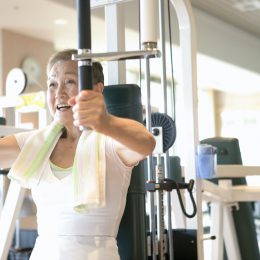Meet HILIT Workouts: A High-Intensity Workout That’s Easier on Your Joints
CrossFit, boot camp, and other HIIT classes are known for getting fast results. Get to know their gentler-but still effective-sibling.

If you’re a fan of short, challenging workouts that get results, you’ve likely heard of high-intensity interval training (HIIT). And if you’re in good physical condition and get proper guidance, HIIT can be a safe workout for older adults. Ditto CrossFit and boot camp classes.
But what if HIIT isn't right for you? What if you need a workout that makes you break a real sweat, but is much easier on your joints and bones?
Enter high-intensity, low-impact training (HILIT). Like HIIT, you'll turn up the intensity for major calorie burn and strength training in a short amount of time. The key difference: HILIT minimizes the impact on your joints and bones to lower the risk of injury.
Here, take a closer look at HILIT, plus get tips on finding a class.
Intensity Versus Impact: A Key Difference
To understand where HIIT and HILIT diverge, it helps to first understand two aspects of exercise: intensity and impact.
Intensity describes how hard your body has to work during exercise. For example, if you walk at a slow pace, that’s low intensity. Running? High intensity.
Whatever type of exercise you prefer, increasing the intensity can improve longevity. And you can do high-intensity intervals with almost any exercise. The trick is to alternate short bursts of working very hard with periods of recovery.
Impact refers to the downward forces on your joints and bones when your body has to bear its own weight against a surface, usually the floor. No- to low-impact activities, like water aerobics and cycling, are known for being joint-friendly. High-impact exercises typically involve skips, hops, and jumps.
When done correctly, high-impact exercise can be safe for older adults. In fact, using as much impact as you can safely tolerate can build stronger bones. The key is to start easy and add impact gradually until you find what’s right for you.
Whether you’re looking to increase the intensity or impact of any exercise, the first step is talking to your doctor about what’s safe for you, especially if you have a chronic condition (including osteoporosis, arthritis, or diabetes); an injury; or balance issues.
The Benefits of HILIT
As their names suggest, the main difference between HILIT and HIIT is the impact. With HILIT, you'll limit jumping and other rapid movements.
In a HILIT class, you might keep one limb on the floor at all times, says Monique Crous, C.P.T., a certified personal trainer and creator of Hot HIIT.
"This prevents many common injuries you tend to see when doing high-impact exercises," she says. "When done right, low-impact training can help you lose weight, tone up, and get strong using just your bodyweight."
You might also see HILIT classes use TRX bands, kettlebells, dumbbells, and rope pulleys, says Jeni Fujita, founder of Mud and Lotus Training Center in New York City. But you’ll see them moving slowly and with control.
Something else you might notice in HILIT classes that’s missing from HIIT: a noncompetitive atmosphere.
Subscribe to our newsletter
It's quick and easy. You could be one of the 13 million people who are eligible.
Already a member? Click to discover our 15,000+ participating locations.
Follow Us
"At my studio, we embrace each person and where they are in their fitness journey," Fujita says. "It's about getting stronger together."
Find the Right HILIT Class for You
Start by asking for class descriptions from a gym manager or instructor. A HILIT class may not always be labeled as such, and sometimes low-impact group classes are hidden in plain sight.
Look for smaller classes, where you're more likely to get personal attention. "Many traditional HIIT classes have large sizes and are all about pushing yourself beyond your limits and working as quickly as possible instead of focusing on alignment and form," Crous says. "If no modifications are given, you can feel defeated. And in many instances, you can get injured."
Older adults and people with injuries may also want to consider one-on-one training to focus on proper form before taking on a group class, Fujita says.
Check out more great tips to find the right group class. Plus, see four low-impact exercises you can try on your own.
Check Your SilverSneakers Eligibility Instantly
SilverSneakers gives you free, unlimited access to more than 16,000 gyms and fitness centers across the nation, plus classes and tools designed to keep older adults strong and independent. Check your eligibility instantly here.
Already a member? Get your SilverSneakers member ID and exclusive content by logging in to or creating your online account here.





